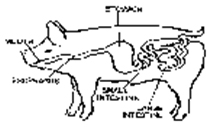The pig has a digestive system which is classified as monogastric or non ruminant. Humans also have this type of digestive system. They have one stomach (mono=one, gastric=stomach). The monogastric differs from that of a polygastric or ruminant digestive system found in cattle and sheep. These animals have one stomach broken into four compartments. Due to the differences in the digestive systems, cattle can utilize different types of feeds than pigs. Cattle and sheep can live on hay and pasture, while pigs must eat grains that can be digested more easily.
Digestion is the break-down of food occurring along the digestive tract. The digestive tract may be thought of as a long tube through which food passes. As food passes through the digestive tract, it is broken down into smaller and smaller units. These small units of food are absorbed as nutrients or pass out of the body as urine and feces.
The digestive tract of the pig has five main parts: the mouth, esophagus, stomach, and small and large intestines ( Figure 1 ). The following discussion explains how each part digests nutrients.



